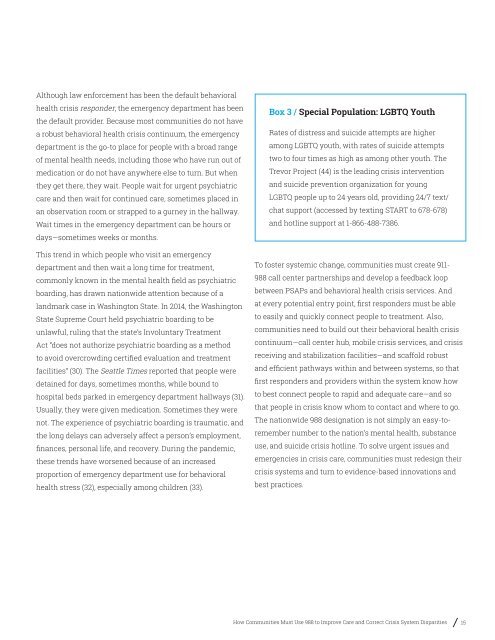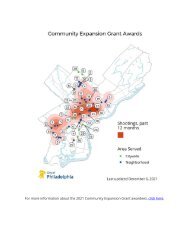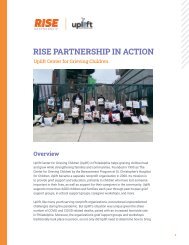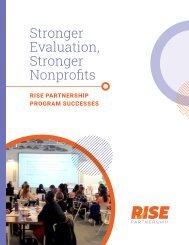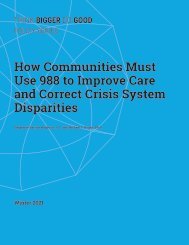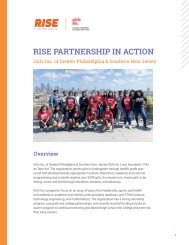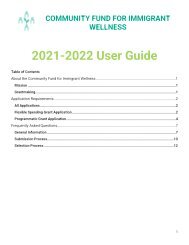Test Add using WordPress E-paper JB Local Environment
JB Local Environment
JB Local Environment
Create successful ePaper yourself
Turn your PDF publications into a flip-book with our unique Google optimized e-Paper software.
Although law enforcement has been the default behavioral<br />
health crisis responder, the emergency department has been<br />
the default provider. Because most communities do not have<br />
a robust behavioral health crisis continuum, the emergency<br />
department is the go-to place for people with a broad range<br />
of mental health needs, including those who have run out of<br />
medication or do not have anywhere else to turn. But when<br />
they get there, they wait. People wait for urgent psychiatric<br />
care and then wait for continued care, sometimes placed in<br />
an observation room or strapped to a gurney in the hallway.<br />
Wait times in the emergency department can be hours or<br />
days—sometimes weeks or months.<br />
This trend in which people who visit an emergency<br />
department and then wait a long time for treatment,<br />
commonly known in the mental health field as psychiatric<br />
boarding, has drawn nationwide attention because of a<br />
landmark case in Washington State. In 2014, the Washington<br />
State Supreme Court held psychiatric boarding to be<br />
unlawful, ruling that the state’s Involuntary Treatment<br />
Act “does not authorize psychiatric boarding as a method<br />
to avoid overcrowding certified evaluation and treatment<br />
facilities” (30). The Seattle Times reported that people were<br />
detained for days, sometimes months, while bound to<br />
hospital beds parked in emergency department hallways (31).<br />
Usually, they were given medication. Sometimes they were<br />
not. The experience of psychiatric boarding is traumatic, and<br />
the long delays can adversely affect a person’s employment,<br />
finances, personal life, and recovery. During the pandemic,<br />
these trends have worsened because of an increased<br />
proportion of emergency department use for behavioral<br />
health stress (32), especially among children (33).<br />
Box 3 / Special Population: LGBTQ Youth<br />
Rates of distress and suicide attempts are higher<br />
among LGBTQ youth, with rates of suicide attempts<br />
two to four times as high as among other youth. The<br />
Trevor Project (44) is the leading crisis intervention<br />
and suicide prevention organization for young<br />
LGBTQ people up to 24 years old, providing 24/7 text/<br />
chat support (accessed by texting START to 678-678)<br />
and hotline support at 1-866-488-7386.<br />
To foster systemic change, communities must create 911-<br />
988 call center partnerships and develop a feedback loop<br />
between PSAPs and behavioral health crisis services. And<br />
at every potential entry point, first responders must be able<br />
to easily and quickly connect people to treatment. Also,<br />
communities need to build out their behavioral health crisis<br />
continuum—call center hub, mobile crisis services, and crisis<br />
receiving and stabilization facilities—and scaffold robust<br />
and efficient pathways within and between systems, so that<br />
first responders and providers within the system know how<br />
to best connect people to rapid and adequate care—and so<br />
that people in crisis know whom to contact and where to go.<br />
The nationwide 988 designation is not simply an easy-toremember<br />
number to the nation’s mental health, substance<br />
use, and suicide crisis hotline. To solve urgent issues and<br />
emergencies in crisis care, communities must redesign their<br />
crisis systems and turn to evidence-based innovations and<br />
best practices.<br />
How Communities Must Use 988 to Improve Care and Correct Crisis System Disparities 15


